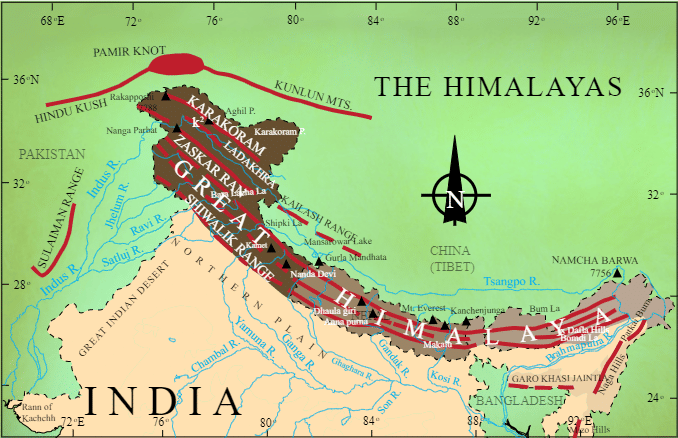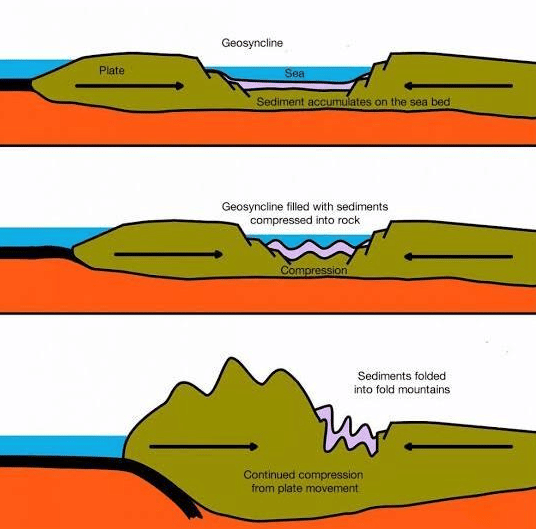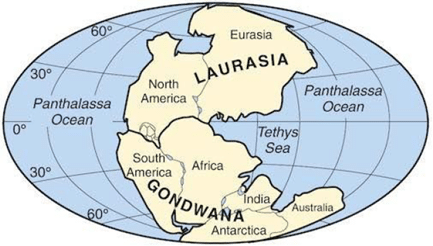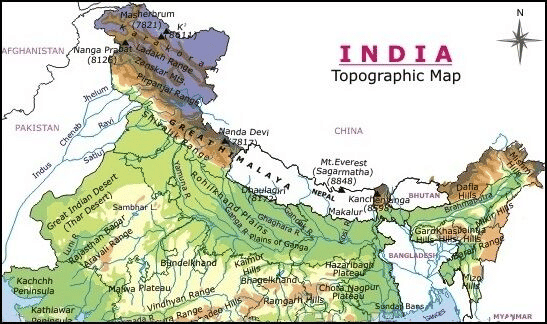The Himalayas - An Introduction - UPSC PDF Download
OVERVIEW
➔ This article aims to study and analyse the Himalayan mountain range.
➔ The extent, features and the origin of the Himalayas are discussed.
➔ The details of the various divisions of the Himalayas are explained.
➔ An analysis of the significance of the Himalayas is attempted.
INTRODUCTION
The Himalaya, a term coined by the ancient people of India which means ‘abode of snow’. The Himalayas continue to inspire awe and wonder in man. From being the home of beautiful hill stations, alpine forests, meadows and animals such as the elusive snow leopard and the magnificent markhor, the Himalayas also serve economic, geographic and geopolitical interests as evident from the recent India-China military stand-off in the western Himalayas. The Himalayas are the youngest and the loftiest mountain chain in the world.

The Himalayan Range
- Central axis range of the main Himalayas stretches over 2500 km from the Indus gorge in the west to the Brahmaputra gorge in the east.
- Width: 500 km in Kashmir to 200 km in Arunachal Pradesh
- Total Area: 5 lakh sq km
EXTENT
From the Pamirs (roof of the world), which is the connecting link between the Himalayas and high ranges of Central Asia, the Himalayas extend eastward as an arcuate curve which is convex to the south. It extends from the peak of the Nanga Parbat in the west to the summit of Namcha Barwa in the east. The southern boundary is well defined by the foothills and the northern boundary is obscure and merges with the Tibet Plateau.

The Extent of the Himalayas
CHARACTERISTICS OF THE HIMALAYAS
- High altitude
- Steep gradient
- Snow capped summits
- Deeply dissected Topography
- Youthful drainage
- Complex Geological Structure
- Rich Temperate flora in the subtropical latitude
ORIGIN OF THE HIMALAYAS
It is believed that the Himalayan mountains have come out of a great geosyncline called the Tethys sea and that the upliftment had taken place in different phases.
Geosyncline - It is a linear trough of subsidence of the Earth's crust within which vast amounts of sediment accumulate. The filling of a geosyncline with thousands or tens of thousands of feet of sediment is accompanied in the late stages of deposition by folding, crumpling, and faulting of the deposits.

Geosynclines
1. High altitude
2. Gentle gradient
3. Deeply dissected Topography
4. Senile Drainage
Choose the correct options from the codes given below:
CHRONOLOGY OF ORIGIN
About 120 million years ago, there was a supercontinent known as Pangea whose northern part consisted of the present North America and Eurasia (Europe and Asia) which was called Laurasia or Angaraland. The southern part consisted of South America, Africa, South India, Australia and Antarctica. This landmass was called Gondwanaland. In between Laurasia and Gondwanaland, there was a long, narrow and shallow sea known as the Tethys Sea.
Pangea and its subdivisions
Sediments were brought by the rivers from these landmasses and deposited in the bed of this sea. The sediments were subjected to powerful compression, which might have been due to the southward movement of Angaraland or the northward movement of Gondwanaland. The sediments in the Tethys sea were squeezed and crushed and a series of folds were formed one behind the other giving birth to the highest relief feature on Earth- THE HIMALAYAS.
The curved shape of the Himalayas convex to the south is the outcome of the maximum push offered at the two ends of the Indian Peninsula (in the northwest by the Aravali and in the northeast by Assam ranges) during its northward drift. Studies have shown that India is moving northwards at the rate of 5cm per year and crashing into the rest of Asia.
The first phase of the Himalayan formation (Greater Himalayas) commenced about 120 million years ago. The second phase took place about 25 to 30 million years ago (Middle Himalayas). The last phase of the Himalayan orogeny (Shiwaliks) took place around 2-20 million years ago.

The Himalayas
The diastrophic movement that helped in Himalayan formation started in the late Cretaceous time and continued through the Eocene, Middle Miocene, Pliocene to the Lower Pliocene and finally into the upper Pleistocene to sub-recent times. However, the process of upliftment of the Himalayas is not yet complete.
FAQs on The Himalayas - An Introduction - UPSC
| 1. What is the significance of the Himalayas? |  |
| 2. How were the Himalayas formed? |  |
| 3. What are the major peaks in the Himalayas? |  |
| 4. How does the Himalayas impact the climate of the Indian subcontinent? |  |
| 5. What are the ecological features of the Himalayas? |  |



















